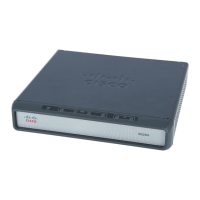Configuring Voice over IP
Voice QoS Basics
15
Cisco AS5350XM and Cisco AS5400XM Universal Gateways Software Configuration Guide
*Apr 26 21:40:51.739: Data Format: ASCII
*Apr 26 21:40:51.739: Data Len : 63
*Apr 26 21:40:51.739: Data : Session 0x0144 Received Tone Off ntf for code 0x0f
from IP side
*Apr 26 21:46:36.431: 00:00:08: Port Trace Event:
*Apr 26 21:46:36.431: Port : 3/00
*Apr 26 21:46:36.431: Address : 0x3000000
*Apr 26 21:46:36.431: Trace Event: 0x2
*Apr 26 21:46:36.431: Data Format: ASCII
*Apr 26 21:46:36.431: Data Len : 43
*Apr 26 21:46:36.431: Data : Session 0x0144 detected 250 msec of silence
*Apr 26 21:46:36.431: 00:00:08: Port Trace Event:
*Apr 26 21:46:36.431: Port : 3/00
*Apr 26 21:46:36.431: Address : 0x3000000
*Apr 26 21:46:36.435: Trace Event: 0x2
*Apr 26 21:46:36.435: Data Format: ASCII
*Apr 26 21:46:36.435: Data Len : 41
*Apr 26 21:46:36.435: Data : Session 0x0144 Ecan State 0x0007 Restored
Voice QoS Basics
Quality of service refers to the ability of a network to provide differentiated service to selected network
traffic over various underlying technologies. QoS is not inherent in a network infrastructure. Rather, you
institute QoS by strategically enabling appropriate QoS features throughout an intranetwork or
internetwork.
Voice traffic differs from data traffic in a number of ways:
• Data is often bursty by nature; voice is deterministic (smooth).
• Data applications resend dropped packets; voice applications can only conceal dropped packets.
• Data applications can usually tolerate some delay; voice applications must minimize delay, so that
the recipient does not hear clips in the transmission.
All of these mandate use of QoS strategies to give strict priority to voice traffic, ensuring reliable
delivery and minimal delay for networks that carry both voice and data.
Note The ITU-T G.114 recommendation specifies, for good voice quality, that no more than 150 ms of
one-way, end-to-end delay should occur. In many situations, 200 ms may be acceptable.
QoS features for voice focus on two things—reliability and predictability. Reliability ensures delivery
without packet loss. Predictability ensures delivery without excessive delay. Together, they serve to
eliminate poor-quality voice transmission, including crackles and missing syllables that render a call
unsatisfactory or even incoherent to the recipient.
Voice traffic requires real-time service, with steady and predictable throughput and low delay. In the
presence of bursty, delay-tolerant data traffic, you must provide for voice traffic a differentiated—that
is, higher-priority—level of service. Because networking equipment and devices that carry both data and
voice cannot differentiate traffic that requires high-priority service from traffic that does not, your only
means for ensuring that voice traffic is expedited or that it receives constant, predictable transmission
across a backbone shared by data traffic is by enabling QoS features.
Effective end-to-end QoS throughout a network must serve disparate users, applications, organizations,
and technologies, all at reasonable cost and effort. QoS features enable you to balance service levels for
user satisfaction, granting priority service to voice while servicing data transmission to the degree of

